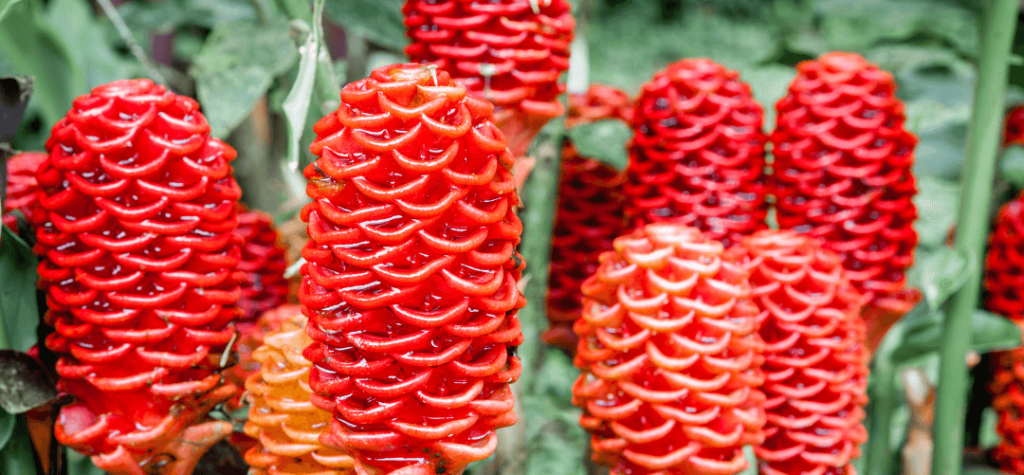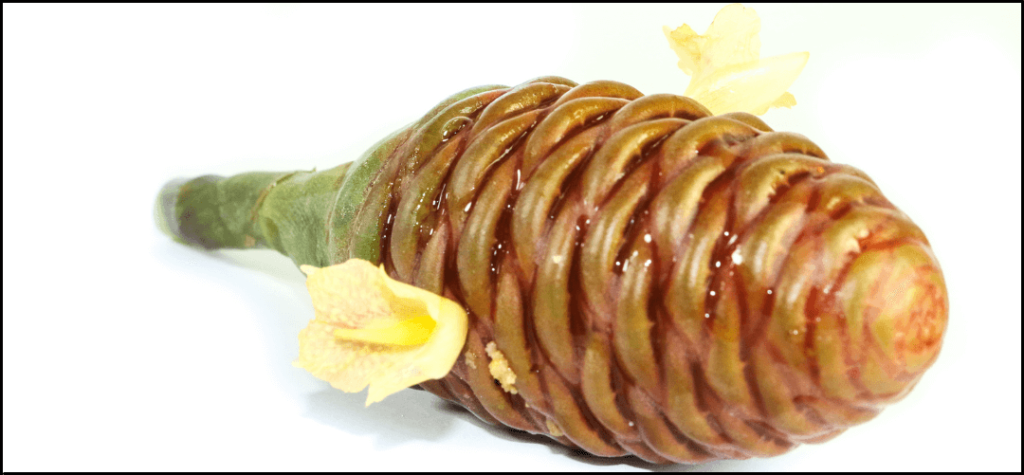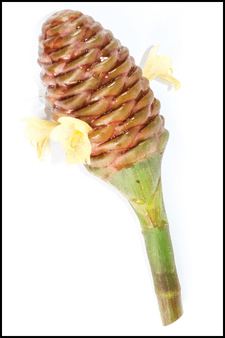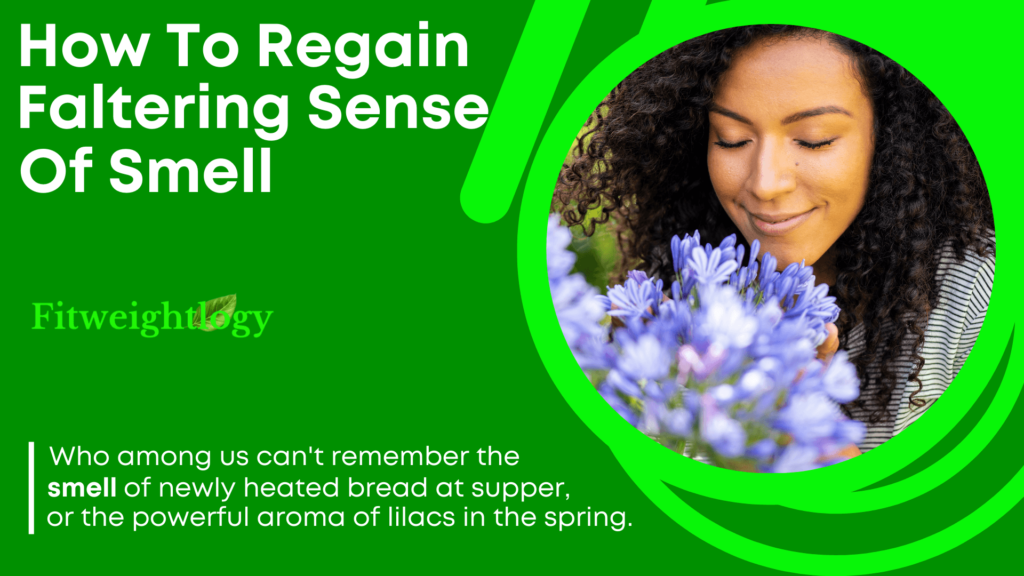Shampoo Ginger is a significant plant for its therapeutic and culinary worth. Many are found in other Asian culinary joys and are generally utilized as spices. The rhizome of the shampoo ginger plant can be sure be eaten, yet it tastes severe when contrasted with ginger customarily sold on the lookout.
What Is Shampoo Ginger Plant?

A rhizomatous, clump-forming perennial of the Zingiber Mill genus and Zingiberaceae family, Zingiber zerumbet (pinecone ginger, shampoo ginger, or wild ginger) is usually referred to as pinecone ginger. Indo-Malesian countries, including India, Malaysia, and Indonesia, are home to the plant’s natural range of tropical plants.
Most of Asia’s tropical regions, including the Chinese mainland and Taiwan (as well as the Indian subcontinent and Laos and Myanmar), grow it in large quantities. Since then, it has spread to various tropical locales in the Pacific Ocean, where it has become established.
Many years ago, Polynesians introduced this tree to Hawaii in their boats. This plant, native to tropical regions, does not remain green all year round since it falls into dormancy in the winter. An East Indian term related to Pali sigivera has given rise to the Greek name for the genus.
Pinecone ginger’s common name refers to the pinecone-shaped inflorescence of the plant. As a shampoo and conditioner, the creamy liquid component in the cones of ginger may be obtained by compressing and applying to hair. Various commercial shampoos include this component. The Rhizome’s popular name, wild ginger, refers to its flavors in different dishes. It’s evident that these rhizomes are edible, yet they taste a lot like commercial ginger rhizomes (Zingiber officinale).
Shampoo Ginger Plants Description
Shampoo Ginger is a tall, erect, herbaceous plant with false stems that grows in clusters and is used to make shampoo. Plants that grow in tropical rainforests, thickets, beaches, mangroves, moist roadway ditches, stream, and river banks. Shady forest regions, forest margins, brushwood, mixed and teak woods, and wastelands near settlements are all examples of where this species may be found growing.
The plant loves soil rich in humus, is wet, and is well-drained. The pinecone ginger’s leaves and inflorescences are produced by a solid knobby rhizome that develops just below the soil’s surface and connects to the rest of the plant.
Zingiber zerumbet, often known as Shampoo Ginger or ‘Awapuhi, is a perennial herbaceous plant that serves various functions. Shoots, rhizomes, and inflorescence fluids are all edible parts of the plant. Rhizomes have long been utilized in therapeutic applications as an anti-diarrheal, anti-inflammatory, de-wormer, and for various pain management uses, among other things. The juice that comes from the inflorescence may be consumed.
Most people are familiar with the floral liquid from ‘awapuhi, which is used as a shampoo or conditioner for hair and skin because it has a calming, glossy, and smoothing impact on the hair and skin. Depending on the kind, this ginger cousin may reach heights of two to four feet. awapuhi, like some other gingers, dies back every year to allow the plant to store energy in its roots and rhizomes.
The plant re-sprouts from these rhizomes in the spring when the weather conditions are optimum. ‘Awaphui may grow into dense thickets, so give them plenty of room or plan to manage them on an annual basis. Because of this, it has not been placed on any invasive species lists, and it has been present on the islands for more than 1,000 years (indicating that it is not usually considered a harmful plant).
Related: 47 Best Health Benefits Of Leaf Of Life Plant – What Is Not Mentioned
Is It Safe To Consume Ginger Root Shampoo?

It is possible to squeeze the “cone” gently enough to release a replenishable clear and scented liquid. It may be used as a hair washing shampoo and a component in cosmetics such as lotions, shampoos, and face washes, among other things.
Is It Possible To Drink Shampoo Ginger?
The juice that comes from the inflorescence may be consumed. Most people are familiar with the floral liquid from awapuhi, which is used as a shampoo or conditioner for hair and skin because it has a calming, glossy, and smoothing impact on the hair and skin. This ginger cousin may reach heights of 2 to 4 feet, depending on the kind.
Common Names Of Shampoo Ginger Plant
Zingiber zerumbet is a plant belonging to the ginger family that grows to approximately 1.2 m (3.9 ft) in height and has leafy stems. It is believed to have originated in Asia; however, it may be found in various tropical nations. Awapuhi, bitter ginger, shampoo ginger (Malay = employing), and pinecone ginger are more common names for this plant.
Z. zerumbet is the scientific name for this species.
Zingiber is a genus of plants.
Zingiberaceae is a family of ginger plants.
Fruit
The flowers are accompanied by an ellipsoid or underachieve fruit that is approximately 0.8-1.5 cm long and 0.8-1.5 cm wide. When the fruit is young, it is green in color, but it changes to red as it matures.
Flower
The flower is produced on a pseudostem that is distinct from the leaves. The inflorescence is in the form of a pinecone, with bracts subtending the location of each flower, providing the inflorescence its pinecone form. Until blossoming, the inflorescence remains green in color. Over a few weeks, the green cone becomes crimson, and tiny flowers begin to form on the top of the cone. Inconspicuous, 3-petalled light yellow or white blooms develop from the lower bracts first; when the flower is gone, it fades and drops away, leaving the bracts in place.
The color of the bracts changes after the flowers have bloomed. After then, the color beginnings upward until the whole inflorescence is brilliant red. A great quick landscape plant for creating a tropical look, the cone-shaped blooms are long-lasting and may be used in floral arrangements for a long time. Flowering usually occurs during July and September.
Leaves
The leaves are many, distichous, sessile or briefly petiolate, green, simple, whole, lanceolate or oblong-lanceolate, and straightforward, whole, lanceolate or oblong-lanceolate. They are 15–40 cm long and 3–8 cm wide, glabrescent or abaxially slightly pilose, with a constricted base and acuminate apex.
History
Z. zerumbet is a species of plant that is endemic to tropical Asia and Oceania. The subspecies Zingiber zerumbet subsp. cochinchinense (Gagnep.) Tribune & K.Larsen (formerly Zingiber cochinchinense) is found in Vietnam, and it was previously known as Zingiber cochinchinense.
The remains of Z. zerumbet have been discovered in the Kuk Swamp archaeological site in New Guinea, in the Phase 1 strata, dating from 10,220 to 9,910 years before. It is not known if the plant was farmed or whether it was just harvested from the wild.
Practices That Are Indigenous To A Culture

While baking in the imu (underground oven), which has a delicious scent, the stems and leaf stalks were utilized to improve the taste of the meat and fish as they cooked.
It was customary to slice the scented subterranean rhizomes and dry them before grinding them up and adding them to the creases of dried Kapa (tapa) fabric to preserve them.
The herb awapuhi is often used as a hair product, not surprising considering its popularity. The clear, fragrant juice found in the full flower heads, which resemble red pine cones, is used to smooth and shine the hair, and it has a
pleasant scent. Besides being kept in the hair or washed out, it is also a massaging lubricant.
Light and Temperature
According to the USDA, bitter ginger is winter hardy in USDA hardiness zones 8 through 10.
They grow best in tropical or subtropical climes, although they may also be grown in moderate conditions on the mainland of the United States. Pinecone ginger plants are planted inside colder locations to prevent freezing.
When grown outside in Central Florida, the pinecone ginger suffers from dieback when the weather shifts from one season to another. This exotic plant thrives in temperatures as high as 32 degrees Fahrenheit (0 degrees Celsius). These perennials thrive in direct sunlight to part shade conditions.
Watering and Feeding
Shampoo ginger should indeed be soaked on a seasonal basis.
Maintain a dry environment throughout the dormant winter months by watering them with free-draining fertilizers during the warm summer months. Fertilize shampoo ginger plants with all fertilizer only during the summer months, in the same way. By the conclusion of the growing season, phosphorus-rich fertilizer should be used to guarantee that the rhizomes are healthy and well-developed.
Soil and Transplanting
Pinecone ginger flourishes when grown in indirect shade and good soil. To thrive, it requires soil with an acidic pH and a light to medium texture. Provide the plant with consistently wet soils throughout the summer, and keep the soil dry during the winter since the plant falls into dormancy and needs less moisture during the winter.
While the plant is tolerant of poor fine sand, hard soils must be amended before planting the plant. Gypsum should be added to the ground before planting the plant. Wild ginger is propagated by the use of seeds and rhizome extracts. Harvesting fresh shampoo ginger rhizomes 10-12 months after planting the plant, ideally in late winter or early spring, will allow you to transplant the plant.
Blossoming with a lingering fragrance
Aromaticum is a broad-leaved shrub that produces spectacular blossoms on inflorescences from August to September. Aromaticum is native to the Mediterranean region. A group of 9 to 12 blade-like evergreens develop on the underground stem throughout the spring season.
During the mid-to late-summer, the thick shampoo ginger rhizomes grow flower spikes, each of which is crowned with an inflorescence that is spherical and vividly colored. This flowering structure, similar to that of a pinecone, is initially surrounded by green, waxy bracts that become a vivid shade of red as they reach maturity.
The red pine boughs have a clean, fragrant perfume similar to ginger. The pinecone-shaped inflorescence has small tri-petalled blooms in shades of yellow and is brimming with creamy white sap that has a fresh, sharp taste and smells like pine needles.
Health Benefits Of Shampoo Ginger Plant
The peppery fresh rhizomes were mashed and used in Hawaii to treat indigestion and other disorders.
In a traditional application, the Rhizome was smashed in a stone mortar with a stone pestle, then combined with a ripe Noni fruit and applied topically to severe sprains to alleviate the symptoms.
Afterward, the pulp was wrapped in a handkerchief and wrapped gently over the damaged region. If you have a toothache or a cavity, the prepared and softened Rhizome may be pushed into the hole and left for as long as is

necessary. The crushed and filtered rhizome material is combined with water and drank to alleviate stomach aches.
There are a variety of advantages to using shampoo ginger plants since some of the compounds in them are beneficial when absorbed by the body. In reality, the chemical found in the Shampoo ginger rhizome may be utilized as the primary element in traditional medicine due to the presence of anti-seizure compounds and the ability to treat high fever. The following are a few recognized health benefits of using ginger shampoo.
1. Overcome Diarrhoea and Dysentery: The Rhizome of shampoo ginger trees is quite beneficial in treating diarrhea and even dysentery. Health conditions that affect the body’s digestive system are more likely to affect children, adults, and even the elderly.
2. Increase Appetite: Shampoo ginger has ingredients that are comparable to the health advantages of Curcuma, and it can boost hunger. Reduced hunger should not be treated lightly since the body will suffer from a lack of dietary intake and vitamins, which will result in a variety of health complications.
3. Overcome Colds: The use of ginger shampoo has a variety of health advantages. A compromised immune system might result in a cold, which will impair the body’s ability to operate to its total capacity. As a herbal remedy for these health issues, we may use shampoo ginger mixed with other natural substances to help us conquer them.
How To Use
Then, grab one Rhizome of shampoo ginger which has been cleaned, grated, and pressed, and place it in a small bowl. Then, strain the juice from the shampoo ginger and mix it with two tablespoons of honey in a half-glass of heated water at room temperature until it is warm. Drink twice a day, many times a week, until the body’s condition improves significantly.
4. Relieve Fever: Seizures may develop in children who have a fever if the condition is not handled immediately. As a result, due to the anti-seizure chemicals in ginger shampoo, you might consider using it as herbal medicine to alleviate the heat. In addition to the advantages of white radish, which is then used to reduce fever, the benefits of this shampoo, which includes ginger, will cure a fever that Paracetamol also accompanies.
5. Slimming Body: Having a slim and perfect figure is something everyone, especially guys, would want to have. It is believed that the ginger content in shampoo might help to increase the smoothness of the body’s metabolism, hence increasing the effectiveness of the fat-burning process.
6. Treat Rheumatic: When the legs are affected by health issues, it is common for them to experience excessive sensations, which are then compounded by a sense of pain in the thighbone. Rheumatoid arthritis is a kind of health disease that affects the legs. Ginger shampoo may be used to treat rheumatoid arthritis.
Combine the shampoo ginger rhizome with the chili java that has been crushed, and then combine with a dry rice combination to make a paste. The different formulations are combined uniformly before being applied to the legs or other body areas, experiencing discomfort or rheumatic symptoms.
7. Overcome Swollen Foot after Giving Birth: Some women who have gone through the delivery process often feel swollen feet due to the procedure. To resolve this issue, you could prepare a combination of shampoo and ginger to restore the state of your feet.
First, take the Rhizome of shampoo ginger and chili Java and smash it with a bit of water until it is powdered. The juice is extracted and consumed in a suitable quantity using a squeeze cloth.
8. Treat TBC: Toxic shock syndrome (TB) sickness is an illness that should not be underestimated due to its symptoms and consequences on the body’s overall health status. Consequently, we should use traditional medicine to cure disease, using ginger shampoo as the primary component.
The ingredients in it aid in the elimination of pollutants from the body. Prepare shampoo ginger by first washing it and then cutting it and boiling it in clean water. To cure TBC, consume three glasses of wine in a single day after that.
9. Treat Malaria: You should treat malaria symptoms as they appear by using the rhizomes of shampoo ginger in conjunction with the other herbs to prevent further spread of the illness. To begin, make the shampoo ginger that has been softened, then add one glass of pineapple and salt and pepper to taste the ginger mixture. Finally, drink half a cup of it every day for a week to strengthen the body’s immune system.
10. Prevent the Progression of Cancer: The ginger extract included in shampoo has the capacity to suppress the growth of cancer cells in the body when applied topically. Cancer cells that have been induced will be hindered from growing if not completely stopped. The body will be safeguarded against the onslaught of cancer due to this treatment.
11. Relieve Skin Irritation: Some individuals used to suffer from skin issues due to food allergies that they were exposed to. As a result, a traditional medication derived from shampoo ginger must cure the condition. As for how to utilize it, first, slice the bitter ginger rhizome into small pieces and then make a tea out of it, which you should drink daily until your allergy symptoms subside.
12. Overcome Low Blood Pressure: Blood pressure will make it challenging to go about your everyday activities. That’s because the person will feel fatigued, and the eyesight will be blurred, which will result in unconsciousness or fainting. The presence of ginger in the shampoo has been shown to enhance the number of platelets in the bloodstream.
The procedure is as follows: first, grate the Rhizome of shampoo ginger, and then combine it with sugar and water before boiling it. One tablespoon of this beverage may be drunk three to four times quite so much, even one tablespoon of water in a single day.
13. Overcome Hemorrhoid: If left untreated, hemorrhoids may develop into a potentially fatal health condition. We should use ginger shampoo to alleviate symptoms and prevent harmful consequences.
14. Relieve Cough: Coughing is a medical condition that causes us to be unable to go about our daily lives. Coughs may be alleviated by using ginger hair shampoo. To begin, combine the Rhizome of bitter ginger with the onion and cinnamon that have been roasted or baked. Then, smash it and press it out to eliminate the liquid consumed with the food item.
How to make use of it
Begin by grating the shampoo ginger rhizome that has been cleaned and ground into a quarter segment. After that, add two tablespoons of hot water and a pinch of salt in a modest amount. Drink a tablespoon of the juice double the day for best results.
Related: 9 Best Genmaicha Tea Health Benefits
How Long Does It Take For Shampoo Ginger To Grow?

Whether you’re planting edible or decorative gingers, they always start out as rhizomes and develop into 3 to 7 feet high plants as they mature. Approximately ten months to a year after planting, harvest fresh rhizomes for eating or transplanting. After the pine-cone-shaped shampoo ginger gets a vivid red, squeeze the juice out of it with your fingers.
What Is The Best Way To Care For A Ginger Shampoo Plant?
Ginger shampoo and Pinecone Ginger are examples of ginger products (Zingiber zerumbet)
1. Feeding the Plants Fertilize on a regular basis to provide the most acceptable appearance.
2. Watering. Maintain equal moisture distribution throughout the soil.
3. Soil. Soil that is fertile and humus-rich.
4. A Brief Overview of Basic Care. Grow in soil that is rich in nutrients and humus. Maintain soil moisture by watering liberally during dry weather. Shelter from severe winds should be provided.
What does the scent of ginger shampoo smell like?
The name “shampoo ginger” comes from a viscous liquid found in the mature flower of Zingiber zerumbet, also known as shampoo ginger. It is used as a shampoo, conditioner, soap, and massage oil, and it has a mild ginger scent to it that is pleasant.
How to propagate Shampoo Ginger
While Zingiber zerumbet may be propagated via the use of seeds and roots purchased from a shop, rhizomes are the preferred method of multiplication.
1. A large clump of thick, juicy, bitter ginger with many buds should be utilized for this application.
2. Wearing gloves and cutting the rhizomes into pieces with a sharp knife is recommended.
3. Each component should be made up of several buds.
4. Keep the pieces for a few days to completely dry the cuts.
5. After that, place the pieces of rhizomes in a jar filled with warm water overnight to soak.
6. In a 5-gallon container, combine equal portions of potting soil and compost and stir until a rich, wet mixture is created by mixing the components well.
7. Plant a few pieces of the mixture half-inch deep in the soil with the buds pointing upwards. Fill the pot halfway with this mixture and plant it.
8. Keep the plant inside in a warm, protected location with filtered light to ensure it thrives.
9. Place it in the sunlight if you live in a colder climate.
10. Water the plant anytime the soil’s top surface feels dry to the touch regularly.
11. Organic fertilizer should be applied twice a week until the rhizomes have sprouted.
Shampoo Ginger Care:
This plant is deficient in maintenance. Plant it, let it grow, and then watch the flowers bloom. This plant will grow in shady conditions and damp soil, among other diseases. Or, to put it another way, it can be planted in areas where most plants would not thrive.
Eating:
Shoots are peppery and composed of still folded leaves when they first emerge. The bitterness of mature rhizomes is considerable; the harshness of juvenile rhizomes is not as strong.
Culture
It is winter hardy to USDA Zones 8-10, where it does best when planted in full sun to part shade in locations with high humidity and regularly wet summer soil. When plants are dormant during the winter months, less soil water is required.
Thick rhizomes, branched and scented, can help plants establish the garden. A single plant may grow into a gigantic cluster that can be seen for miles around with time. Rhizomes may not need to be pulled in the autumn to overwinter inside in Zones 8-10; however, a wintertime mulch may be necessary for some areas of Zone 8.
Rhizomes must be removed in the autumn and moved inside to overwinter in an excellent environment if located north of Zone 8. Rhizome division is the most effective propagation method in the winter season to early spring.
Traditional Uses

1. Gastralgia, debility, vertigo, and constipation were all treated with the Rhizome in Malaysia, according to local custom.
2. The fresh rhizomes were used to remedy edema, stomach discomfort, and sores by the Malays.
3. It is possible to cure youngsters who have worm infestations using the juice of the cooked rhizomes.
4. In Indonesia, a decoction of the Rhizome is used as an appetizer and to relieve stomach discomfort.
5. In the Philippines, the decoction is indicated for treating asthma and as a topical treatment for rheumatism.
6. The Chinese macerate, the rhizomes in alcohol and utilize the resulting mixture as a tonic, depurative, and stimulant, among other things.
7. The Chinese employed dietary fiber and anti-inflammatory adjuvants for stomach discomfort, sprain, and fever, among other ailments.
8. In Thailand, pure rhizomes are also utilized as an anti-flatulent medication to relieve flatulence.
9. For treating severe pain in India, rhizome powder is combined with ripened Morinda citrifolia fruit and consumed.
10. Teethache, cough, asthma, worms, leprosy, and other skin illnesses may be treated with cooked and softened Rhizome, which is then applied topically.
11. Stomach discomfort may be relieved by drinking a mixture of ground and filtered Rhizome combined with water.
12. Bruse and wounds are treated with compressed rhizomes, also used in Hawaii to cure migraines, toothaches, ringworm, joint sprains, and stomach colic, among other ailments.
13. Additionally, they used ashes from burnt Z. zerumbet leaves, which were combined with a mixture of ashes from Schizostachyum glaucifolium, nut sap from Aleurites moluccana, and rhizome sap from Z. zerumbet, as a solution for cuts and bruised skin, as well as ashes from Schizostachyum glaucifolium, nut sap from Aleurites moluccana, and Rhizome
14. Polynesia is a component in several medicinal treatments used to cure ear irritation and diarrhea.
15. A rhizome decoction is used to soak after delivery in Brunei Darussalam, and warmed leaves are used as a poultice to relieve arthritis and aching muscles in the country’s capital.
16. In New Guinea, this plant is employed in male ceremonies and has been claimed to cause women to become infertile.
17. Also stated to be used on the head of children experiencing convulsions and the head and stomach of youngsters suffering from fever are applications of this remedy.
18. To increase the Appetite, fresh rhizomes are squeezed and mixed with water.
19. To treat stomach pain and leg cramps, treat puerperal infection, and as a general tonic, tRhizomeome is used in Malaysia.
20. In Java and Malaysia, powdered rhizomes are administered to the body after delivery to promote healing.
21. Rhizome was traditionally pounded in a stone mortar and pestle, then combined with ripe Noni fruit and applied topically to severe sprains to alleviate the pain and inflammation.
22. The damaged region was wrapped with a cloth that had been loosely tied around the pulp.
Culinary Uses
1. Flower buds are cooked and eaten like vegetables in several parts of the world.
2. Young shoots a Rhizomeome are being used as a savory flavor in the same manner as ginger is used in Asian cuisine.
3. In Java, young ends of rhizomes, scraped or roughly chopped, are eaten uncooked with rice as a lab (a kind of noodle).
4. Young flower spikes that have not yet developed bracts are also consumed, either raw or cooked.
Grooming And Maintenance

The perennial shampoo ginger is a hardy and fast-growing plant that may cover an entire garden in years if grown in the right circumstances.
Because of the addition of mulch to the soil and protecting the roots and rhizomes from freezing, these plants may survive the winter in USDA Zone 8.
However, in locations situated in the northern reaches of Zone 8 and up to Zone 10, the rhizomes should be harvested and stored inside for the winter. When temperature dip
below 55 degrees Fahrenheit (13 degrees Celsius), potted plants should be brought inside and protected from the cold.
Snip the leaves that fall to the ground after the first cold to prevent them from growing back. If an infestation occurs, monitor for pests and spray the leaves with a powerful water jet and plant-based horticultural oil to prevent further damage. When hot and humid weather, avoid applying oils to your skin.
Other Facts
1. Zingiber zerumbet is a kind of ginger, while Curcuma xanthorrhiza is turmeric.
2. Recent developments in the market have resulted in various products produced from the leaves extract of these species being sold in the format of spray-dried powder packaged in sachets or bottles.
3. In Hawaii, the milky sap extracted from the flower cones is used as a shampoo.
4. For its distinctive inflorescence, the plant is grown as an ornamental plant, and it has become a famous cut-flower due to its extended shelf life (up to several weeks).
5. In India, essential oils are used as perfumes in soaps and toiletries after being blended with other fragrances to create a unique scent.
6. In Hawaii, the milky fluid derived from the pine cones is renowned for being used as a wash.
Learn More: Jojote (Spanish Plum) – What Is It Exactly?
Characteristics To Take Note Of

It is known by many names, including pinecone ginger, shampoo ginger, and wild ginger. Native to India and Southeast Asia, it is often grown as a houseplant in domestic gardens worldwide. This species has been imported and naturalized in various tropical locations of the Pacific Ocean during human history.
This plant was introduced to Hawaii by Polynesians in boats thousands of years ago. Even though it is native to tropical regions, this plant falls dormant in the winter and, as a result, is not evergreen. On upright stems that may grow up to 4′ tall, each plant produces 9-12 blade-shaped leaves (each up to 8″ long) throughout the spring season.
During the mid-to-late summer, flower stalks arise from the rhizomes, each being capped by a rounded inflorescence (up to 4″ tall), which is composed of overlapping, green waxy bracts that resemble pine cones.
Flowers with three petals that are light yellowish-white in color begin to bloom from between the bracts, one at a time and are inconsequential. After blooming is complete, the inflorescences turn brilliant scarlet and mature to a deep purple.
Since the flowering stalks are shorter than the leafing stalks, they are often hidden inside the plant’s foliage. In regions of eastern Asia, rhizome extracts have long been employed in herbal therapy, and this is no exception.
The genus name Zingiber is supposed to descend from the Greek word for ginger, gingivitis, which is thought to derive from the Sanskrit term for ginger, shringavera, which is believed to derive from the Greek name for ginger, gingivitis. This plant’s common name, pinecone ginger, refers to inflorescence, shaped like a pinecone.
Shampoo ginger is a popular term for the creamy liquid material found in the cones of the plant that may be extracted by squeezing and used as a hair shampoo and hair conditioner, according to specific sources. Some commercial shampoos include this chemical as an additional component.
The popular term for wild ginger refers to Rhizomeome as a food component for culinary seasoning in various cuisines. These rhizomes are edible; however, they have a harsh taste compared to the rhizomes of commercial ginger that are widely offered (Zingiber officinale).
If you’re considering buying a cleanser, you’ll need to determine what type of scalp you have. The motivation behind a cleanser is to dispose of the oil, soil, and dead cells that are collected on your scalp; thus, it is intended for your scalp. If you have a slick scalp, choose a cleanser made to suit people with sleek scalps.
Picking the right kind of canine cleanser is surprisingly troublesome in light of the fact that chosen items can be founded on numerous standards, including skin type, coat length, and clinical issues. One thing is sure – canine cleanser is generally the ideal choice, and human cleanser ought to be kept away from no matter what.
Not exclusively is our cleanser at an alternate pH to that of a canine’s skin, yet it additionally utilizes a lot more extreme fixings than a canine cleanser. Ordinary shampoos contain numerous cordial fixings. Your skin and hair benefit from these cleansers. It can forestall dandruff and scalp issues.
Natural shampoos are like regular shampoos and are easy to understand. The most natural cleanser additionally contains regular fixings. Everyday shampoos and natural shampoos can leave you with glossy, sleek hair, very much like a business cleanser. The hair becomes saturated, and harmed hair becomes fixed.
Be that as it may, some are not totally regular. You might observe they are blended in with a substance base, containing a portion of those destructive fixings. While picking a natural or regular cleanser, you ought to guarantee it is 100 percent normal.
The best ginger shampoos are those like normal shampoos which contain regular fixings. Ginger cleanser permits your hair to get a deep scrub without the hair’s traditional oils being stripped. Ginger shampoos help to increment hair development and, along these lines, are great for individuals experiencing going bald.
Sage and thyme are two regular fixings found in ginger cleansers, which smooth the scalp. The going bald cycle in men can be dialed back by utilizing homegrown cleansers, which is a significant advantage for men.
Please Be Aware: Statements in this article is certainly not meant to address, cure, treat or even identify any disease or either been evaluated by the Food and Drug Administration. Instead, it is only for informational reasons that it is composed.
Please, you should see your doctor or a certified medical practitioner for those who have any health problem in any respect before taking any supplement you find here or elsewhere.
 | Fitweightlogy’s content writers’ team constantly contributes to writing high-quality content linked with all the best products associated with weight loss, healthy lifestyle, fitness, tips, and motivation. Furthermore, provide tips on beauty and nutrition. |
Latest Posts
- What to Eat at KFC: Healthy Menu Choices and Nutrition Facts
- 18 Best Essential Oils For Neck And Back Pain Relief – The Highly Effective Guide
- Health Benefits of Fenugreek Oil for Hair, Digestion, Inflammation & More
- What Is Meringue Powder? – What About Meringue Powder Substitutes?
- The Health Benefits of Mixed Tocopherols – Uses, Side Effects & More
Posted in
Welcome to Fitweightlogy! We are an optimum review website of all the best products associated with weight loss, healthy life, fitness, tips, and motivations. We are a quickly developing organisation given that we typically put our visitors first. A customer-focused experience has regularly been our objective, and we value our comprehensive policies, which have placed us in a domain well beyond our competitors. On this website, we assist our visitors in reaching their desired weight, appearance goals and live a healthy lifestyle, as well as save money and time by meticulously researching and evaluating the market, assessing the available products, and producing informative recommendations based on factors such as quality, availability, price and more. Furthermore, our passion is to assist you in choosing the best possible product through our product reviews.








